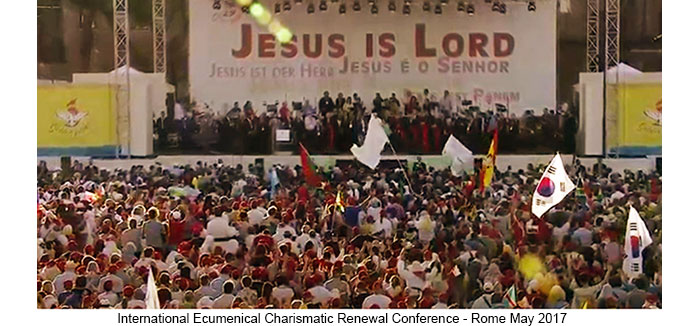From the very beginning of covenant community life, many of the leaders and members shared a deep conviction that living as an ecumenical community was a foundational element of their call. The earliest covenant communities – The Word of God in Ann Arbor, the People of Praise in South Bend, and the Work of Christ in Lansing – were ecumenical and remain so. The Servants of the Word, who have households in several communities and provide many leaders in outreach, are likewise an ecumenical brotherhood. The Association of Communities and the subsequent Federation of Communities were ecumenical. The Sword of the Spirit today remains an international, ecumenical community of communities, living out a call from God to demonstrate in daily life that Christians from diverse traditions can live and serve together in unity.
While there are fewer ecumenical communities in the Sword of the Spirit than there are Catholic communities, they are a very important part of the network as a whole. The Sword of the Spirit has always fostered local ecumenical community and continues to do so today.
Lebanon is a center of Christianity in the Middle East. Surrounded by Muslim-majority countries, it has a high percentage of Christians, and among them a large number of churches – Greek Orthodox, Syriac Orthodox, Armenian Orthodox, Maronite Catholics, Greek Catholics, Syriac Catholics, Chaldean Catholics, Latin Catholics and Catholic Copts. The group that began the People of God community in Beirut were mostly Maronite Catholics, but the community now includes members of a wide variety of churches and traditions. In addition to building community among the Christians of Lebanon, the People of God has engaged in active ecumenical outreach throughout the region. This has given rise to several communities in recent years, including two mainly Armenian Orthodox communities, Illuminator’s Lamp in Beirut and Temple of the Holy Spirit in Istanbul, Turkey, as well as Emmanuel, an ecumenical community in Aleppo, Syria; The Crown of the King, a Greek Orthodox community in Antioch, Turkey; and Jesus is Alive, an ecumenical community in Haifa, Israel.
In Belfast, Northern Ireland, the emergence of an ecumenical community can be regarded as a true miracle, given the history of active hostility between Catholics and Protestants. However, it did happen. What is now the Charis community originated from the merger of a Protestant house church and a Catholic charismatic prayer group in 1979. They constituted a powerful ecumenical witness at a time when “the Troubles” – in which paramilitary groups aligned with Protestant and Catholic factions were active – had not yet come to an end. In 1987 they merged with a Presbyterian youth group and became a single community in the Sword of the Spirit. While they suffered from the disruptions in the Sword of the Spirit around 1990, the nucleus of a community survived, incorporating an ecumenical membership from all the founding groups.
Árbol de Vida, the ecumenical community in San José, Costa Rica, started as a group of Catholic and Evangelical university students who met for prayer and Christian outreach in common. The group experienced its own Pentecost in 1973 and became a charismatic group. During the same year, one of the members went to study at Michigan State University and came in contact with the community that was soon to become the Work of Christ. It was through contact with the Work of Christ, and later The Word of God, that the group in San José began to form a community, then called Agapé, which joined the Sword of the Spirit in 1983. Their current name, Árbol de Vida (Tree of Life) came through prophecy and was adopted in 1989. The community has been one of the leading communities in Latin America and a statement of ecumenical hope in a generally Catholic cultural environment.
While most communities have arisen spontaneously from prayer groups or from outreaches of other communities, Antioch Community in London, ecumenical from the start, owes its origin, as mentioned earlier, to a joint invitation in 1979 from the Catholic Archbishop of Westminster and the Anglican Bishop of Kensington made to the leaders of The Word of God and the People of Hope to start an ecumenical community in London.
The Lamb of God community, an ecumenical community with branches in various parts of the two islands of New Zealand, was founded in 1979 and was already a community when it began to make contact with the Federation of Communities in the early 1980s. Although there was contact over the following fifteen years, the community did not affiliate with the Sword of the Spirit until 1996, becoming a full member in 2006. It is one of the most diverse communities in the Sword of the Spirit, representing many ethnic groups including English, Maori, Filipino, Indian, and Chinese. It has outreaches in the South Pacific, including a community in Fiji, called Patmos, and several Pentecostal churches in that country.
Seeking a Formal Relationship with the Catholic Church
From almost the start the leaders in Ann Arbor were concerned to develop structures which would make possible good relationships with the churches to which their members belong, and that is what led to development of the “fellowships” described in chapter 3. But now that the Sword of the Spirit existed as an international, ecumenical community, the leaders had to consider how to establish ecumenical community on an international basis. While some of the communities they invited into the Sword of the Spirit were ecumenical, most were entirely Catholic, and this reality led to development of an approach to relationship with the Catholic Church on an international basis.
The Catholic Fellowship in The Word of God became the model for relating the Catholics in the Sword of the Spirit to the Catholic Church as a whole. The name adopted for this wider fellowship was Christ the King Association. Since the Sword of the Spirit was originally conceived as a single community of which local communities were branches, the Christ the King Association was likewise a single fellowship with branches in each community. These branches would then relate each to the local Catholic bishop in each locality. At the same time, the Catholic leaders in the community sought to establish an official relationship between the Christ the King Association and the Vatican. This effort received the support of a number of important officials.
With the new constitution of the Sword of the Spirit in 1990, in which the model of the single community was replaced by that of a community of separate communities, the Christ the King Association changed in the same manner. It now constituted an association of Catholic fellowships and communities. For several years, some Catholic communities, whose local bishops were not comfortable with the ecumenical nature of the Sword of the Spirit, were members only of the Christ the King Association.
The leaders of the Christ the King Association hoped that the Association would be recognized by the Catholic Church in the way that many of the local Catholic communities and fellowships had been recognized by their local bishops. This seemed possible: in 1990, a group of Catholic communities and fellowships, including some that had been part of the former Association or Federation of Communities, was officially recognized as the Catholic Fraternity of Covenant Communities and Fellowships, on the basis of the fellowship model that had first been used in Ann Arbor.
However, in May 2003, the Secretary of the Pontifical Council for the Laity, Archbishop (later Cardinal) Stanisław Ryłko informed the Council of the Sword of the Spirit that it would be impossible to provide official recognition for the Christ the King Association because of its relationship with the Sword of the Spirit. He made it clear that this did not mean that the Council for the Laity disapproved of either the Christ the King Association or the Sword of the Spirit. In fact, they supported both, but they could not set up a formal relationship. It was noted, both by the Council for the Laity and the Sword of the Spirit Council, that Catholic communities in the Sword of the Spirit, and Catholic groupings within ecumenical communities, had formal recognition in over sixty dioceses throughout the world.
In 2006, the joint Councils of the Christ the King Association and the Sword of the Spirit decided to abandon the structure of two parallel organizations. A new set of statutes, approved in 2008, redefined Christ the King Association to comprise all Catholics in the Sword of the Spirit. At the same time, a new grouping, the Association of Ecumenical Communities (AEC), with its own Council, was formed to include the ecumenical communities. Its purpose was to ensure that all concerns for the ecumenical nature of the Sword of the Spirit and the needs of ecumenical communities would be met.[1] In most cases, the other church bodies with members in the Sword of the Spirit do not have the kind of juridical structures the Catholic Church has, but ecumenical communities in the Sword of the Spirit maintain good relations with the pastors of the various churches whose members are part of the communities.
From the very beginning the communities have engaged in outreach together with Christian leaders from many churches and traditions. For instance, all of our communities are asked to participate yearly in the Week of Prayer for Christian Unity sponsored by the World Council of Churches and the Catholic Church’s Pontifical Council for Promoting Christian Unity. One of the central purposes of the Sword of the Spirit is to fulfill the prayer of Jesus “that all may be one.”A rather public example of ecumenical collaboration is the Sword of the Spirit’s participation in the celebration in Rome of the Fiftieth Anniversary of the Catholic Charismatic Renewal held in May of 2017. The two organizers of the 5-day celebration, the International Catholic Charismatic Renewal Services and the Vatican’s Council for the Laity – fully aware that it was ecumenical – asked the Sword of the Spirit to collaborate closely with two other community networks, the Catholic Fraternity and the ecumenical European Network of Communities to present the communities stream of the event. Bruce Yocum, the former Moderator of Christ the King Association, and Jean Barbara, President of the Sword of the Spirit, addressed the sessions, attended by thousands of members from the various streams of covenant community.
[1] The area of ecumenism was considered so important that the Sword of the Spirit Assembly in 2016 transformed the AEC into the Ecumenical Commission as a direct agent of the International Executive Council to foster our ecumenical call in all of our communities – whether they are ecumenical or Orthodox or Catholic.
This article © 2021 The Sword of the Spirit is adapted from A Brief History of the Sword of the Spirit, by Bruce Yocum, Bob Bell and Henry Dieterich, commissioned by the International Executive Council of the Sword of the Spirit to mark the 50th anniversary of covenant community.
This is part of the series: A Brief History of the Sword of the Spirit
- Bruce Yocum, leader of the writing team, and author in his own right, has been part of the communities movement since 1968 and has held various leadership roles over the past 50 years. He was instrumental in the formation and growth of numerous communities in the Sword of the Spirit. He currently resides in London, England, and is part of Antioch, a member community of the Sword of the Spirit.
- Henry Dieterich has been present in Ann Arbor, Michigan, USA, for most of the time since the beginnings of the communities movement. He holds a doctorate degree in history from the University of Michigan and did most of the actual writing of the history, fostering a rigorous standard of historical research and accuracy. Henry lives in Ann Arbor with his wife Roz and is a member of Word of Life there, a community of the Sword of the Spirit.
- Bob Bell was also present in Ann Arbor for decades, starting in the autumn of 1967 and an eyewitness to much of the early history of the Sword of the Spirit and the communities movement. He was also part of the start-up team for Jerusalem, the Sword of the Spirit community in Belgium. He works for the Sword of the Spirit administrative and editorial staff and has made his home in London, England, and is also part of Antioch, a member community of the Sword of the Spirit.



